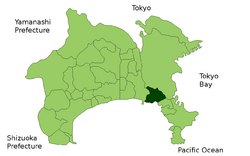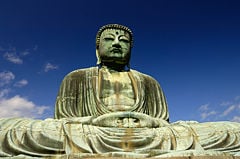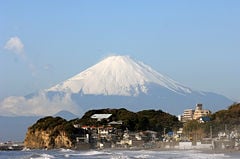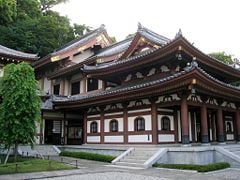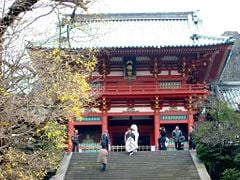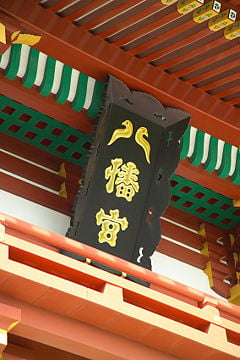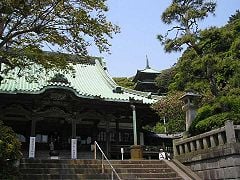Kamakura
| Kamakura ťéĆŚÄČŚłā |
|||
| ‚ÄĒ¬†¬†City¬†¬†‚ÄĒ | |||
|
|||
| Kamakura in Kanagawa Prefecture | |||
| Coordinates: 35¬į19‚Ä≤N 139¬į33‚Ä≤E | |||
|---|---|---|---|
| Country | Japan | ||
| Region | KantŇć | ||
| Prefecture | Kanagawa | ||
| Government | |||
|  - Mayor | Takashi Matsuo (Politician) | ||
| Area | |||
|  - Total | 39.60 km² (15.3 sq mi) | ||
| Population (March 1, 2010) | |||
|  - Total | 174,016 | ||
|  - Density | 4,390/km² (11,370/sq mi) | ||
| Website: City of Kamakura | |||
Kamakura (Japanese: ťéĆŚÄČŚłā; -shi) is a city located in Kanagawa, Japan, about 31 miles (50 km) south-south-west of Tokyo (to which it is linked by the Yokosuka Railway Line to Yokosuka, Kanagawa). Minamoto no Yoritomo established the first Bakufu (shognate) in Kamakura in twelveth centry, and moved his political center from Kyoto to Kamakura. After the shift, new Buddhist movements emerged and Buddhist culture flourished. Many of Kamakura's 65 temples and 19 shrines were established during Kamakura period. In 1333, Emperor Go-Daigo re-established power in Kyoto, but until it vanished into anonymity in the late fifteenth century, Kamakura retained its status as an important religious, cultural, political, and military center.
Kamakura remained a religious destination for pilgrimages because of its grand temples; in the last century, it has become a tourist destination and an attractive residential area because of its historical and cultural environment and its proximity to Tokyo. Kamakura has a beach which, in combination with the temples, makes it an ideal site for tourism. Kamakura is also noted for its "senbei," which are crisp rice cakes, grilled and sold fresh along the main shopping street. These are popular with tourists, especially Japanese tourists. The city is well-provided with restaurants and other tourist-oriented amenities.
Description
Kamakura (Japanese: ťéĆŚÄČŚłā; -shi) is a city located in Kanagawa, Japan, about 31 miles (50 km) south-south-west of Tokyo (to which it is linked by the Yokosuka Railway Line to Yokosuka, Kanagawa). Surrounded by mountains on three sides and the open water of Sagami Bay on the fourth, Kamakura is a natural fortress, only one hour‚Äôs train ride south of Tokyo. Many of the 65 temples and 19 shrines were established around eight centuries ago, when, for a short period, Kamakura was Japan‚Äôs political and military hub (Dodd and Richmond 2001, 218).
As of January, 2007, the city has an estimated population of 172,877.[1] The total area of Kamakura is 25 mi¬≤ (39.53 km¬≤) with a circumference of 22 miles (35.30 km).[2] The city flower is the Gentian, a purple flower with leaves resembling those found on bamboo grass; and the city tree is a wild cherry tree.[3] The City Emblem, established November 3, 1952, is the ‚Äúsasarindou,‚ÄĚ a crest design with bamboo grass leaves and gentian flowers.[4] Kamakura is noted for its "senbei," which are crisp rice cakes, grilled and sold fresh along the main shopping street. These are very popular with tourists, especially Japanese tourists. Kamakura is famous for a biscuit called Hatosabure, a biscuit shaped like a pigeon. It is sold next to Kamakura station and a very popular omiyage (souvenir) among the Japanese. Kamakura has a beach which, in combination with the temples makes it an ideal tourist location. The city is well-provided with restaurants and other tourist-oriented amenities. Kamakura is also the terminal for the Enoshima Electric Railway, locally known as "Eno-den." This traditional narrow gauge railway runs to Fujisawa; to the west, part of the route takes it parallel to the seashore.
History

In the Genpei Wars (1180-1185), there was a power struggle between two militaristic clans, the Minamoto (also known as Genji) and the Taira (also known as Heike). Lord Kiyomori of the Taira clan was first to gain power, but spared the lives of the Minamoto brothers, Yoritomo and Yoshitsune. In the Battle of Dannoura (1185), the Minamoto fleet, commanded by Yoshitsune defeated the Taira. There then began a rival between the Minamoto brothers that led to eventually led to the winning brother, Yoritomo, creating his Bafuku (tent government) at Kamakura in 1192 (Dodd and Richmond 2001, 831).
The military aspect of the government was given predominance; military governors worked alongside civil administrators and taxes were imposed to support the military. Semi-feudalism, where peasants were given land to farm in return for loyalty to their local lord, was established throughout Japan. After his death in 1199, Yoritomo’s Bafuku struggled to survive under his descendants who lacked his intense character and organizational skills (Dodd and Richmond 2001, 831).
Over the subsequent century, many majestic monuments were constructed in Kamakura. Monks fleeing the Song dynasty of China founded many Zen temples with the support of the warrior class that ‚Äúshared similar ideals of single-minded devotion to duty and rigorous self-discipline‚ÄĚ (Dodd and Richmond 2001, 220). In 1219, power passed to the HŇćjŇć clan, who administrated as regents behind figurehead shoguns. After the Mongol invasions in the late thirteenth century, the HŇćjŇć clan‚Äôs power began to diminish. In 1333, Emperor Go-Daigo re-established power in Kyoto, leaving the last HŇćjŇć regent and 800 retainers to commit seppuku (ritual suicide by disembowelment) (Dodd and Richmond 2001, 220). Before vanishing into anonymity in the late fifteenth century, Kamakura retained its status as an important military center. Kamakura continued to remain a religious destination for pilgrimages because of its grand temples; and in the last century, has turned into a tourist destination and an attractive residential area because of its proximity to Tokyo.
Tourism
Walking and public transportation are the recommended modes of transportation throughout the city since roads are almost too narrow for out-of-town drivers. Kamakura Station is located in the middle of Kamakura, and the most famous temples and shrines can be found within about a 2-mile radius (3-kilometer radius).
Places of Interest[5]
- Amanawa Shinmeijinja Shrine ‚Äď Allegedly the oldest shrine in Kamakura, it was built at the start of the eighth century.
- Ankokuronji Temple ‚Äď A Nichiren Buddhist temple with a copper bell, an Amehiko haiku-inscribed monument, and a view of Mt. Fuji.
- Anyouin Temple ‚Äď The main sanctuary houses statues of Senju-kannon (a Kannon with 1,000 hands and 1,000 eyes), Bishamon (one of Kamakura‚Äôs seven gods, the god of war), and HŇćjŇć Makako.
- Asahina Pass ‚Äď One of Kamakura‚Äôs seven Kiridoshi (steep slopes), it is designated as a national historic site.
- Choshoji Temple ‚Äď A Nichiren Buddhist temple that was reconstructed in 1345 that houses a statue of Nichiren and ‚ÄúMashiroki Fujinone,‚ÄĚ a tanka-inscribed monument.
- Daibutsu (Kotokuin Temple) ‚Äď Better known as Kamakura Daibutsu, this temple is hoem to Daibutsu, a 37-feet-tall (11.31-meter-tall) gilt bronze seated statue. The Daibutsu statue is Kamakura‚Äôs only national treasure that is a statue of Buddha.
- Daigyouji Temple ‚Äď This temple was called ‚ÄúOnmesama‚ÄĚ (the god for the trouble-free delivery of children) and is famous for being the meeting place where Minamoto Yoritomo planned the battle that would lead to his victory. After this victory, the temple‚Äôs name was changed to Daigyoji.
- Daihoji Temple ‚Äď A principal image of Buddha called Sanpo Soshi, statues of Nichiren, Nisshutsu, and Minamoto Yoshimtsu, and a statue of Kishibojin are housed in this temple.
- Egaratenjinsha Shrine ‚Äď Built 1104, the shrine houses Kappa Fudezuka (a picture of Shimizu Kon of Kappa, a legendary water sprite), a picture of Kappa by a cartoonist, and an Ozaki Meidou haiku-inscribed monument.
- Eishoji Temple ‚Äď The only nunnery in Kamakura, founded in 1636.
- Engakuji Temple ‚Äď Number two of the five Kamakura temples, Engakuji was founded in 1282. The main sanctuary houses a wooden statue portraying a seated Shakyamuni Gautama.
- Enmeiji Temple ‚Äď Founded by Senrenjahouyonokou saint, this temple houses a statue of Migawari Jizo.
- Ennoji Temple ‚Äď This temple is a reconstructed Arai-enmado after the temple originally on the Yuigahama coast was destroyed by an earthquake and tsunami in 1703. It worships the ten kings called Jyuo.
- Fudarakuji Temple ‚Äď Founded in 1181, has many treasures that have connections with Minamoto Yoritomo.
- Genjiyama Park ‚Äď Located behind the Eishoji and Jufukuji temples, this park attracts many people during cherry blossom season.
- Godaido Myo-o-in Temple ‚Äď Founded in 1235, the Godaido Myo-o-in Temple‚Äôs sanctuary houses a statue of Godai Myo-o, a wooden statue designated as a municipal cultural asset.
- Gokurakuji Temple ‚Äď Founded in 1259, Gokurakuji is the only temple in Kamakura that belongs to the Shingon Risshu Buddhist sect.
- Gokurakuji Pass ‚Äď The Gokurakuji Kiridoshi slope (one of Kamakura‚Äôs seven Kiridoshi, or steep slopes) made it possible for a small army to block Nitta Yoshisada‚Äôs entry into Kamakura.
- Goryojinja Shrine ‚Äď Every year, on September 18, there is an event called ‚ÄúMenkake Gyoretsu‚ÄĚ where ten people parade the streets wearing monstrous masks.
- Goshojinja Shrine ‚Äď Constructed in 1908, it is home to Ita-bi (a grave monument which is designated as a national important art object), and Koshin-to (the Blue Warrior‚Äôs tower).
- Grave of Minamoto Yoritomo ‚Äď The grave tower stands where there had been a sanctuary called Jibutsudo, which was called Hokkedo after Yoritomo died. This tower is believed to have been rebuilt in 1779 and is designated a national historic site.
- Hakusanjinja Shrine ‚Äď A standing statue of Bishamon (the god of war) is housed here. A sacred twisted rope called Shimenawa, is located in the front of the shrine.
- Hasedera Temple ‚Äď The principal statue, that of a Buddha with eleven faces is 30 feet (9.18 meters) tall, and is believed to be Japan‚Äôs largest wooden statue.
- Hongakuji Temple ‚Äď Constructed in 1436, a sanctuary called Ebisudo where Ebisu (the god of fishermen) is enshrined, can be found here, along with the grave of Okazaki Goro Masamune.
- Hokaiji Temple (Hagidera) ‚Äď Constructed in 1335, Hokaiji is famous for the white bush clovers found on its grounds in the fall.
- Hokokuji Temple ‚Äď Founded in 1334, Hokokuji is famous for it bamboo garden.
- Inamuragsaki Seaside Park ‚Äď A view of Sagami Bay with Mt. Fuji and Enoshima island in sight.
- Jissoji Temple ‚Äď Reconstructed in 1621, this temple is home to the grave of Nissho.
- Jyomyoji Temple ‚Äď Founded in 1188, Jyomyoji houses a grave tower where Ashikaga Sadauji is buried.
- Jochiji Temple ‚Äď Founded in 1281, Jochiji has a wooden sculpture of a seated Buddha with sleeves and skirts hanging down.
- Joeiji Temple ‚Äď Founded in 1606, Joeiji, also called ‚ÄúBotamochi-dera,‚ÄĚ houses Sazikini (nun) and Saemonnojou Sukenobu tomb as well as a Tsukamoto Ryusai tanka-inscribed monument.
- Jogyoji Temple ‚Äď Founded in 1313, Jogyoji has the grave of Hiroki Matsunosuke.
- Jyojuin Temple ‚Äď Constructed in 1219, Jyojuin was believed to be the place where Kobodaishi, founder of the Shingon Buddhist sect, lit a holy fire for prayer.
- Jokomyoji Temple ‚Äď Founded in 1251, Jokomyoji houses Amida Sanson (a wooden statue of a Buddhist image), and Yahiroi Jizo (a wooden statue of Jizo, the guardian deity of children).
- Jorakuji Temple - Constructed in 1237, Jorakuji’s main sanctuary houses a statue of Rankei Doryu.
- Jufukuji Temple ‚Äď Built in 1180, the graves of HŇćjŇć Masako and Minamoto Sanetomo, as well as many monuments.
- Kaizoji Temple ‚Äď Rebuilt in 1394, Kaizoji houses a statue of Yakushi Nyorai (the god of medicine).
- Kakuonji Temple ‚Äď Founded in 1296, Kakuonji‚Äôs main sanctuary is where a wooden statue of Yakushi Sanson, Jyuni Shinsho (a set of twelve statues), and Ashikaga Takauji‚Äôs epitaph are kept.
- Kamakura Museum of Literature ‚Äď The building is an important architectural structure because it features rare examples of Western architecture imported in the early Showa period. The museum has a collection of literary works associated to the city of Kamakura.
- Kamakuragu Shrine ‚Äď Built in 1869, Kamakuragu Shrine has a treasure house, Hori Sokyu tanka-inscribed monument, and the ruins of a jail (called Doro).
- Kamegayatsuzaka Pass ‚Äď One of Kamakura‚Äôs seven Kiridoshi (steep slopes).
- Kenchoji Temple ‚Äď Founded in 1253, Kenchoji highlights a Chinese layout of its main constituents. A 730-year-old Byakushin tree stands in front of the Butsuden building. Kenchoji is the main temple of the Kenchoji faction of the Rinzai Buddhist sect.
- Kewaizaka Pass ‚Äď One of Kamakura‚Äôs seven Kiridoshi (steep slopes).
- Kokuzodo ‚Äď A sanctuary that is home to a statue of Kokuzo Bosatsu (a Buddha that is thought to grant any wish).
- Komachi Dori ‚Äď A street that starts from the East exit of Kamakura Station and ends at the Tsurugaoka Hachimangu shrine. There are a variety of traditional souvenir shops, boutiques and restaurants.
- Komyoji Temple ‚Äď The graveyard of the Naito family (patrons of the temple) can be found here, along with two gardens, Kishu Teien and Sanson Goso Raigo.
- Kousokuji Temple ‚Äď Founded in 1279, the wooden statue of Amida Nyorai can be found in Kousokuji‚Äôs main sanctuary.
- Kosokuji Temple ‚Äď A 150-year-old aronia tree can be found on Kosokuji‚Äôs grounds, along with a Miyazawa Kenji poem-inscribed monument, Sugi Chouu tanka-inscribed monument, and Rissyou-ankoku-rom monument.
- Koyurugijinja Shrine ‚Äď The warrior, Sasaki Moritsuna, founded the Koyurugijinja here after he was impressed with the spectacular view from the top of the hill.
- Kuhonji Temple ‚Äď Believed to have been constructed in 1337, Kuhonji‚Äôs main sanctuary houses tablets with calligraphic characters thought to be Nitta Yoshisada‚Äôs writing.
- Kuzuharagaokajinja Shrine ‚Äď Hino Toshimot‚Äôs grave (designated as a national historic spot), as well as a Miyasita Suishu haiku-inscribed monument are found in Kuzuharagaokajinja.
- Manpukuji Temple ‚Äď Famous for being the location where Minamoto Yoshitsune washed his hands.
- Monument to Takahama Kyoshi‚Äôs Residence ‚Äď Takahama Kyoshi was a haiku poet who moved to Kamakura in 1910. Takahama Kyoshi resided here, where a stone monument is inscribed with one of his haiku‚Äôs in his own writing.
- Monument to the Government House of Okura ‚Äď (1180-1225) Minamoto Yoritomo set up his public residence in 1180 at Okura.
- Monument to the Government House at Utsunomiya Zushi ‚Äď (1225-1236) After the death of HŇćjŇć Masako (Minamoto Yoritomo‚Äôs wife), HŇćjŇć Yasutoki transferred the governmental headquarters to this location in 1225.
- Monument to the Government House of Wakamiya Oji ‚Äď (1236-1333) A monument to the headquarters of the Kamkura government, called Shinno Yashiki (or royal residence), which existed during the rule of its fourth Shogun Fujiwara Yoritsune through its ninth, Morikuni Shinno.
- Moto-hachiman (Yui Wakamiya) ‚Äď Minamoto Yoriyoshi who was ‚ÄúSagaminokami‚ÄĚ was believed to have enshrined a guardian deity of the Genji family here when he visited Kamakura in 1063.
- Myohoji Temple ‚Äď Also known as ‚ÄúKokedera‚ÄĚ (moss temple), Myohoji has a Matsubagayatsu-Goshouan-Reiseki stone monument, Houyouin grave tower for Morinaga Shinno, Kawaminami Masako haiku-inscribed monument, and a Hoshino Tatsuko haiku-inscribed monument.
- Myohonji Temple ‚Äď Founded in 1260, Myohonji has many monuments on its grounds, as well as the graves of the Hiki family.
- Nagoe Pass ‚Äď One of Kamakura‚Äôs seven Kiridoshi (steep slopes).
- Nichiren Koimizu ‚Äď One of Kamakura‚Äôs five famous springs.
- Ofuna Kannonji Temple ‚Äď The Ofuna Kannon statue (construction of the statue started in 1929, and was completed in 1961 after a short period of discontinuation during World War II) can be found here.
- Prefectural Flower Center Ofuna Botanical Garden ‚Äď Opened in 1962, 5,700 species of plants are currently grown here.
- Raigoji Temple ‚Äď Originally the site for Nozoji Temple, Raigoji was later founded as a Jishu Buddhiste sect temple. The graves of the warriors Miura Oosuke Yoshiaki and Tatara Shigeharu can be found on the grounds.
- Renjoin Temple ‚Äď Although it is a sub-temple of Komyoji, it existed before Komyoji was constructed. Gotenjo (coffered ceilings) and Ita-fusumae (wooden sliding doors with decorative pictures) can be found in Renjoin.
- Rokkaku-no-I ‚Äď One of Kamakura‚Äôs ten famous wells, Rokkaku-no-I is also called Ya-no-ne (arrow‚Äôs root).
- Roku Jizo ‚Äď Six statues of Jizo, all with red hats and bibs, are lined up beside the road. There is also a monument inscribed with a haiku by Matsuo Basho and a stone monument to Kekachibatake.
- Ruins of Tamanawa Castle ‚Äď Built in 1512, Tamanawa Castle received many attacks by armies during the Sengoku era. It surrendered to Toyotomi Hideyoshi in 1590, and was dismantled in 1619.
- Ryuhoji Temple ‚Äď Transferred to this site in 1575, a monument to Arai Hakuseki stand on the premises.
- Ryukoji Temple ‚Äď An old execution ground, Ryukoji is known for its five-storied pagoda, and a cave where Nichiren was confined for execution.
- Sanzagaike Forest Park ‚Äď Constructed around the Sanzagaike pond, the park is home to many wild birds and insects.
- Sasukeinarijinja Shrine ‚Äď Many steps that go through numerous Torrii gates with red flags, require visitors to climb up to Sasukeinarijinja. A monument inscribed with a haiku by Kaneko Kazumine can be found on the grounds.
- Senjuin Temple ‚Äď A monument to Terakoya inscribed with a haiku by Matsuo Basho can be found on the Senjuin grounds.
- Shichirigahama Beach ‚Äď Listed on Japan‚Äôs directory of hundred most scenic beaches, Shichirigahama Beach is not suitable for swimming. Instead, people enjoy yachting and wind surfing in the high waves.
- Shomyoji Temple ‚Äď Streams and waterfalls can be found on the premises.
- Sugimotodera Temple ‚Äď Sugimotodera is thought to be the oldest holy Buddhist site in Kamakura. Three wooden statues of a standing Kannon Bosatsu (Goddess of Mercy) as well as a monument with a haiku by Ozaki Ryodo can be found on the grounds.
- Sunshodo ‚Äď Built in 1936, Sunshodo is a mix of temple and castle attributes, featuring a tower with Sourin.
- Tamanawa Kubizuka ‚Äď A mound where 35 warriors of the Watauchi Fukuhara and Ofuna Amakasu clan were killed in battle and buried in 1526. Six Jizo in a row can be found on the premise.
- Tenshozan (View from the hill at the beach of Komyoji Temple) ‚Äď Tenshozan offers a view of Zaimokuza coast, Inamuragasaki cape, Enoshima island, and Mt. Fuji. This is one of Kanagawa‚Äôs 50 most beautiful scenic areas.
- Tokeiji Temple ‚Äď Founded in 1285 by a nun who rescued many wives from unhappy marriages. A uniquely decorated wooden Shokannon statue as well as ancient documents and Makie works can be found on the grounds.
- Tsurugaoka Hachimangu Shrine ‚Äď A Homotsuden (treasure house), Sugaraba haiku-inscribed monument, Minamoto Sanetomo tanka-inscribed monument, the Kamakura Kokuhokan museum, and a prefectural art museum can be found on the premises.
- Wakaejima Island ‚Äď The nation‚Äôs oldest artificial island harbor can be found off the coast of Zaimokuza.
- Yoshiya Nobuko Memorial Museum ‚Äď Yoshiya Nobuko was a female novelist who wrote about women‚Äôs feelings of Showa from Taisho. She built her house in Kamakura in 1962, and after her death, it was donated to the city.
- Zeniarai Benten Shrine ‚Äď The shrine is known as a location to wash money in hopes of receiving financial success. The water, called Zeniarai-mizu (money-washing water), is one of Kamakura‚Äôs five famous waters.
- Zuisenji Temple ‚Äď Founded in 1327, Zuisenji is home to a garden designed by the founder Muso Soseki, a statue of Jizo Bostatzu called Dokomoku Jizo, and a Yamazaki Houdai tanka-inscribed monument.
Sister Cities
 Ashikaga, Japan
Ashikaga, Japan Hagi, Japan
Hagi, Japan Ueda, Japan
Ueda, Japan Nice, France
Nice, France Dung Huang, China
Dung Huang, China
Notes
- ‚ÜĎ Kamakura GreenNet (2007). Introduction to Kamakura (in English). Kamakura City Official Web Site.. Retrieved September 17, 2007.
- ‚ÜĎ Kamakura GreenNet (2007). Introduction to Kamakura (in English). Kamakura City Official Web Site. Retrieved September 17, 2007.
- ‚ÜĎ Kamakura GreenNet (2007). Introduction to Kamakura (in English). Kamakura City Official Web Site. Retrieved September 17, 2007.
- ‚ÜĎ Kamakura GreenNet (2007). Introduction to Kamakura (in English). Kamakura City Official Web Site. Retrieved September 17, 2007.
- ‚ÜĎ The information on these attractions was taken from Kanagawa city guide. To find extensive detail on these attractions, go Asahi.net
Resources
- Alspaugh, Emmanuelle, and Deborah Kaufman. 2005. Fodor's Japan. New York: Fodor's. ISBN 140001364X ISBN 9781400013647
- Dodd, Jan, and Simon Richmond. 2005. The rough guide to Japan. London: Rough Guides. ISBN 1843532727 ISBN 9781843532729
- Harris, Victor, and Ken Matsushima. 1991. Kamakura: the renaissance of Japanese sculpture, 1185-1333 = Kamakura jidai no chŇćkoku. London: Published for the Trustees of the British Museum by British Museum Press. ISBN 0714114510 ISBN 9780714114514
- Kawashima, Terry. 2001. Writing margins: the textual construction of gender in Heian and Kamakura Japan. Harvard East Asian monographs, 201. Cambridge, MA: Harvard University Asia Center. ISBN 0674005163 ISBN 9780674005167
- Mass, Jeffrey P. 1982. Court and Bakufu in Japan: essays in Kamakura history. New Haven: Yale University Press. ISBN 0300026536 ISBN 9780300026535
- Mass, Jeffrey P. 1979. The development of Kamakura rule, 1180-1250: a history with documents. Stanford, Calif: Stanford University Press. ISBN 0804710031 ISBN 9780804710039
- MŇćri, Hisashi. 1974. Sculpture of the Kamakura period. New York: Weatherhill. ISBN 0834810174 ISBN 9780834810174
- Payne, Richard Karl. 1998. Re-visioning "Kamakura" Buddhism. Honolulu: University of Hawaii Press. ISBN 082482024X ISBN 9780824820244 ISBN 0824820789 ISBN 9780824820787
- Rowthorn, Chris. 2005. Japan. Footscray, Vic: Lonely Planet. ISBN 1740599241 ISBN 9781740599245
- Shinoda, Minoru. 1960. The founding of the Kamakura shogunate, 1180-1185. Records of civilization: sources and studies, no. 57. New York: Columbia University Press.
| |||
| Cities | |||
|---|---|---|---|
| Atsugi | Ayase | Chigasaki | Ebina | Fujisawa | Hadano | Hiratsuka | Isehara | Kamakura | Kawasaki | Minamiashigara | Miura | Odawara | Sagamihara | Yamato | Yokohama (capital) | Yokosuka | Zama | Zushi | |||
| Districts | |||
| Aiko | Ashigarakami | Ashigarashimo | Koza | Miura | Naka | |||
|
Credits
New World Encyclopedia writers and editors rewrote and completed the Wikipedia article in accordance with New World Encyclopedia standards. This article abides by terms of the Creative Commons CC-by-sa 3.0 License (CC-by-sa), which may be used and disseminated with proper attribution. Credit is due under the terms of this license that can reference both the New World Encyclopedia contributors and the selfless volunteer contributors of the Wikimedia Foundation. To cite this article click here for a list of acceptable citing formats.The history of earlier contributions by wikipedians is accessible to researchers here:
The history of this article since it was imported to New World Encyclopedia:
Note: Some restrictions may apply to use of individual images which are separately licensed.

